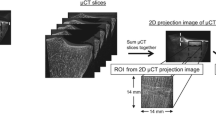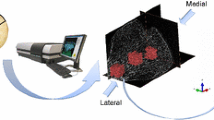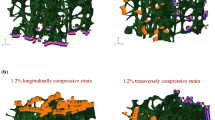Abstract
Summary
Radiographic images of bone cores taken from cadaver proximal femora provided two-dimensional parameters of projected trabecular patterns that correlated highly with conceptually equivalent three-dimensional parameters in the same cores. Measurements also highly correlated with yield stress, suggesting that both parameters have similar biomechanical qualities.
Introduction
We compared morphometric measurements of trabecular patterns in two-dimensional (2D) projection radiographic images of cores from cadaver proximal femoral bones with conceptually equivalent measurements from three-dimensional microcomputed tomography (3D µCT) images.
Methods
Seven cadaver proximal femora provided 47 excised cores from seven regions. Digitized radiographs of those cores were processed with software that extracts trabecular patterns. Measurements of their distribution, geometry, and connectivity were compared with 3D parameters of similar definition derived from µCT of those cores. The relationship between 2D and 3D measurements and yield stress was also examined.
Results
2D measurements strongly correlated with conceptually equivalent measurements obtained using 3D µCT. In all cases, the correlation coefficients were high, ranging from r = 0.84 (p < 0.001) to r = 0.93 (p < 0.001). The correlation coefficients between 2D and 3D measurements and yield stress of the cores were also high (r = 0.60 and 0.82, p < 0.001, respectively).
Conclusions
These findings provide correlative and biomechanical evidence supporting the qualitative similarity of 2D microstructural parameters extracted from plain proximal femoral core X-ray images to conceptually equivalent 3D microstructural measurements of those same cores.



Similar content being viewed by others
References
Melton LJ 3rd (2003) Adverse outcomes of osteoporotic fractures in the general population. J Bone Miner Res 18:1139–1141
Burge R, Dawson-Hughes B, Solomon DH, Wong JB, King A, Tosteson A (2007) Incidence and economic burden of osteoporosis-related fractures in the United States, 2005–2025. J Bone Miner Res 22:465–475
Seeman E, Delmas PD (2006) Bone quality—the material and structural basis of bone strength and fragility. N Engl J Med 354:2250–2261
Rockoff SD, Zettner A, Albright J (1967) Radiographic trabecular quantitation of human lumbar vertebrae in situ. II. Relation to bone quantity, strength and mineral content (preliminary results). Invest Radiol 2:339–352
Rockoff SD (1967) Quantitative microdensitometric x-ray analysis of vertebral trabecular bone. A preliminary report. Radiology 88:794–796
Geraets WGM, van der Stelt PF, Lips P, van Ginkel FC (1998) The radiographic trabecular pattern of hips in patients with hip fractures and in elderly control subjects. Bone 22:165–173
Ouyang X, Majumdar S, Link TM, Lu Y, Augat P, Lin J, Newitt D, Genant HK (1998) Morphometric texture analysis of spinal trabecular bone structure assessed using orthogonal radiographic projections. Med Phys 25:2037–2045
Caligiuri P, Giger ML, Favus M (1994) Multifractal radiographic analysis of osteoporosis. Med Phys 21:503–508
Jennane R, Harba R, Lemineur G, Bretteil S, Estrade A, Benhamou CL (2007) Estimation of the 3D self-similarity parameter of trabecular bone from its 2D projection. Med Image Anal 11:91–98
Lin JC, Grampp S, Link T, Kothari M, Newitt DC, Felsenberg D, Majumdar S (1999) Fractal analysis of proximal femur radiographs: correlation with biomechanical properties and bone mineral density. Osteoporos Int 9:516–524
Majumdar S, Weinstein RS, Prasad RR (1993) Application of fractal geometry techniques to the study of trabecular bone. Med Phys 20:1611–1619
Apostol L, Boudousq V, Basset O, Odet C, Yot S, Tabary J, Dinten JM, Boiler E, Kotzki PO, Peyrin F (2006) Relevance of 2D radiographic texture analysis for the assessment of 3D bone micro-architecture. Med Phys 33:3546–3556
Chappard D, Retailleau-Gaborit N, Legrand E, Basle MF, Audran M (2005) Comparison insight bone measurements by histomorphometry and microCT. J Bone Miner Res 20:1177–1184
Pothuaud L, Benhamou CL, Porion P, Lespessailles E, Harba R, Levitz P (2000) Fractal dimension of trabecular bone projection texture is related to three-dimensional microarchitecture. J Bone Miner Res 15:691–699
Veenland JF, Grashius JL, van der Meer F, Beckers AL, Gelsema ES (1996) Estimation of fractal dimension in radiographs. Med Phys 23:585–594
Luo G, Kinney JH, Kaufman JJ, Haupt D, Chiabrera A, Siffert RS (1999) Relationship between plain radiographic patterns and three-dimensional trabecular architecture in the human calcaneus. Osteoporos Int 9:339–345
Arnaud CD, Liew S, Steines D, Nazarian A, Mueller R, Linder BJ, Lang P (2003) Correlation of 2D trabecular structure parameters with 3D µCT and measurements of bone strength in femoral bone cores. J Bone Miner Res 18(Suppl 2):S56
Arnaud CD, Steines D, Liew S, Nazarian A, Snyder B, Linder BJ, Lang P (2003) Fracture load of fresh-frozen cadaveric proximal femora correlates much better with non-invasive, 2D radiographically derived micro-structural and macro-anatomic indices than with BMD. J Bone Miner Res 18(Supp 2):M107
Nazarian A, Muller J, Zurakowski D, Muller R, Snyder BD (2007) Densitometric, morphometric and mechanical distributions in the human proximal femur. J Biomech 40:2573–2579
Hildebrand T, Laib A, Muller R, Dequeker J, Ruegsegger P (1999) Direct three-dimensional morphometric analysis of human cancellous bone: microstructural data from spine, femur, iliac crest, and calcaneus. J Bone Miner Res 14:1167–1174
White SC, Rudolph DJ (1999) Alterations of the trabecular pattern of the jaws in patients with osteoporosis. Oral Surg Oral Med Oral Pathol Oral Radiol Endod 88:628–635
Russ JC (1999) The image processing handbook. CRC, Boca Raton
Soille P, Rivest J (1996) On the validity of fractal dimension measurements in image analysis. J Vis Commun Image Represent 7:217–229
Kleinbaum DG, Kupper LL, Muller KE (1988) Applied regression analysis and other multivariable methods. PWS, Boston
Uchiyama T, Tanizawa T, Muramatsu H, Endo N, Takahashi HE, Hara T (1999) Three-dimensional microstructural analysis of human trabecular bone in relation to its mechanical properties. Bone 25:487–491
Lespessailles E, Jullien A, Eynard E, Harba R, Jacquet G, Ildefonse JP, Ohley W, Benhamou CL (1998) Biomechanical properties of human os calcanei: relationships with bone density and fractal evaluation of bone microarchitecture. J Biomech 31:817–824
Lochmuller EM, Poschl K, Wurstlin L, Matsuura M, Muller R, Link TM, Eckstein F (2008) Does thoracic or lumbar spine bone architecture predict vertebral failure strength more accurately than density? Osteoporos Int 19:537–545
Lochmuller EM, Kristin J, Matsuura M, Kuhn V, Hudelmaier M, Link TM, Eckstein F (2008) Measurement of trabecular bone microstructure does not improve prediction of mechanical failure loads at the distal radius compared with bone mass alone. Calcif Tissue Int 83:293–299
JT PP, Lochmuller EM, Kuhn V, Nieminen MT, Eckstein F (2008) Experimental hip fracture load can be predicted from plain radiography by combined analysis of trabecular bone structure and bone geometry. Osteoporos Int 19:547–558
Parfitt AM (1992) Implications of architecture for the pathogenesis and prevention of vertebral fracture. Bone 13(Suppl 2):S41–47
Keaveny TM, Hoffmann PF, Singh M, Palermo L, Bilezikian JP, Greenspan SL, Black DM (2008) Femoral bone strength and its relation to cortical and trabecular changes after treatment with PTH, alendronate, and their combination as assessed by finite element analysis of quantitative CT scans. J Bone Miner Res 23:1974–1982
Steines D, Arnaud D, Liew S, Vargas-Voracek R, Bauer DC, Cummings SR, Hess P (2005) Predicting hip fracture in a sub-group of subjects from the study of osteoporotic fracture using automated structural measurement of proximal femur in pelvic radiographs. J Bone Miner Res 20(Suppl 1):S66
Conflicts of interest
Dr. Steines, Dr. Arnaud, Mr. Liew, and Dr. Vargas-Voracek are employees of Imaging Therapeutics Inc. and own stock in the company. Dr. Lang and Dr. Hess are members of the board of directors of Imaging Therapeutics Inc. and own stock in the company. All other authors have no conflicts of interest.
Author information
Authors and Affiliations
Corresponding author
Additional information
Phase 1 NIH SBIR 1 R43 AR049655
Rights and permissions
About this article
Cite this article
Steines, D., Liew, SW., Arnaud, C. et al. Radiographic trabecular 2D and 3D parameters of proximal femoral bone cores correlate with each other and with yield stress. Osteoporos Int 20, 1929–1938 (2009). https://doi.org/10.1007/s00198-009-0908-z
Received:
Accepted:
Published:
Issue Date:
DOI: https://doi.org/10.1007/s00198-009-0908-z




